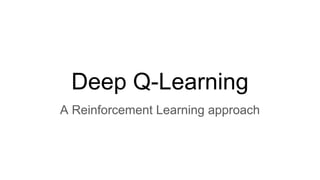
Deep Q-Learning
- 1. Deep Q-Learning A Reinforcement Learning approach
- 2. What is Reinforcement Learning? - Much like biological agents behave - No supervisor, only a reward - Data is time dependent (non iid) - Feedback is delayed - Agent actions affect the data it receives
- 3. Examples - Play checkers (1959) - Defeat the world champion at Backgammon (1992) - Control a helicopter (2008) - Make a robot to walk - Robocup Soccer - Play ATARI games better than humans (2014) - Defeat the world champion at Go (2016) Videos
- 4. Reward Hypothesis All goals can be described by the maximisation of expected cumulative reward - Defeat the world champion at Go: +R / -R for winning/losing a game - Make a robot to walk: +R for forward, -R for falling over - Play ATARI games: +R / -R for increasing/decreasing score - Control a helicopter: + R / -R following trajectory / crashing
- 6. Fully Observable Environments Fully Observable Environments (agent state = environment state): - Agent directly observes environment - Example: chess board Partially Observable Environments (agent state not equal environment state): - Agent indirectly observes environment - Example: A robot with motion sensor or camera - Agent must construct its own state representation
- 7. RL components: Policy and Value Function Policy is agent’s behaviour function - Maps from state to action - Deterministic policy: - Stochastic: Value function is a is a prediction of future reward - Used to evaluate state and select between actions -
- 8. Model Predicts what environment will do next:
- 9. Maze example: r = -1 per time-step and policy [David Silver. Advanced Topics: RL]
- 10. Maze example: Value function and Model [David Silver. Advanced Topics: RL]
- 11. Exploration - Exploitation dilemma
- 12. Math: Markov Decision Process (MDP) Almost all RL problems can be formalised as MDPs It’s a tuple: - S is finite set of states - A is finite set of actions - P is state transition probability matrix: - R is a reward function: - Discount factor:
- 13. State-Value and Action-Value functions, Bellman eq. Expected return starting from state s, and then following policy : Expected return starting from state s, taking action a, and then following policy :
- 14. Finding an Optimal Policy - There is always optimal policy for any MPD - All optimal policies achieve the optimal value function - All optimal policies achieve the optimal action-value function All you need is to find
- 15. Bellman Opt Equation for state-value function [David Silver. Advanced Topics: RL]
- 16. Bellman Opt Equation for action-value function [David Silver. Advanced Topics: RL]
- 17. Bellman Opt Equation for state-value function [David Silver. Advanced Topics: RL]
- 18. Bellman Opt Equation for action-value function [David Silver. Advanced Topics: RL]
- 20. Q-Learning - model-free off-policy control algorithm Model-free (vs Model-based): - MDP model is unknown, but experience can be sampled MDP - Model is known, but is too big to use, except by samples Off-policy (vs On-policy): - Can learn about policy from experience sampled from some other policy Control (vs Prediction): - Find best policy
- 21. Q-Learning [David Silver. Advanced Topics: RL]
- 22. DQN - Q-Learning with function approximation [Human-level control through deep reinforcement learning]
- 23. [Human-level control through deep reinforcement learning]
- 24. Issues with Q-learning with neural network - Data is sequential (non-iid) - Policy changes rapidly with slight changes to Q-values - Policy may oscillate - Experience flows from one extreme to another - Scale of rewards and Q-values is unknown - Unstable backpropagation due to large gradients
- 25. DQN solutions - Use experience replay - Breaks correlations in data - Learn from all past policies - Using off-policy Q-learning - Freeze target Q-network - Avoid policy oscillations - Break correlations between Q-network and target - Clip rewards and gradients
- 26. Neon Demo
- 27. Links - Human-level control through deep reinforcement learning - Course: David Silver. Advanced Topics: RL - Tutorial: David Silver. Deep Reinforcement Learning - Book: Sutton, Barto. Reinforcement learning - Source Code: simple_dqn - Reinforcejs - The Arcade Learning Environment
